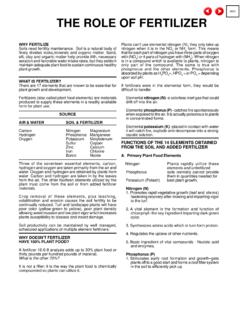Transcription of Xanthium - studyjapan.go.jp
1 1 I Read the following passage and answer the subsequent questions using the answer sheet. In very small quantities , plant hormones, such as [ 1 ], [ 2 ], [ 3 ], [ 4 ] and [ 5 ], regulate the growth and development of plants. [ 1 ], [ 2 ] and [ 3 ] promote plant growth, whereas [ 4 ] and [ 5 ] inhibit it. A major function of [ 1 ] is the acceleration of cell enlargement, for [ 2 ] the promotion of stem elongation and for [ 3 ] the acceleration of cell division, whereas [ 4 ] promotes the falling of leaves and the acceleration of [ 5 ] fruit [ 6 ] in addition to the inhibition of plant growth. Plant hormones are synthesized in an organ of the plant body, and in many cases are transported to other organs to show their activities.
2 For example, [ 2 ] and [ 3 ] are mainly synthesized in roots, and transported to the apical meristem or leaves through [ 7 ] by transpiration flows. [ 5 ] is a gas and how this hormone is transported in the plant body had long been unknown. Now, however, we know that 1-aminocyclopropane-1-carboxylic acid (ACC), the [ 8 ] of [ 5 ], is the form of the transportation of [ 5 ]. Other than these 5 hormones, such substances as brassinolide and jasmonic acid are recognized as plant hormones. Flowering is a very important physiological event for plants and affected by environmental factors, especially 1temperature and 2daylength. 3 Chailakhyan clarified that a substance synthesized in a leaf is transported to the apical meristem and promotes flower bud initiation there, using a [ 9 ] plant, cocklebur ( Xanthium ).
3 This substance to promote flower bud initiation, synthesized in a leaf, is called [ 10 ]. The true character of [ 10 ] had not been known for a long period, but recently it was revealed that [ 10 ] was a protein called [ 11 ]. 1 Fill in the blanks ( [ 1 ] [ 11 ] ) in the above passage from the list given below and record the appropriate letters (A Z) in the designated spaces (I 1 (1)~(11)) on the answer sheet. A abscisic acid B adrenalin C ATP D auxin E cytokine F cytokinin G day-neutral H ethylene I florigen J FT K gibberellin L globulin M juvenilization N long-day O malic acid P maturation Q metabolite R oxaloacetic acid S phloem T polyphenol U precursor V product W propylene X RuBP Y short-day Z xylem 2 2 Which of the following sentences is incorrect as an explanation of the relationship between flowering and temperature, as shown in the underlined part 1 above?
4 Record the letter (A D) of the incorrect sentence in the designated space (I 2) on the answer sheet. A Many of plants that germinate in autumn and flower in the next spring require a certain period of low temperatures for flower bud initiation. B Many of plants that germinate in spring and flower in summer require a certain period of low temperatures for flower bud initiation. C Flowering of short-day plants is affected only by temperature when the daylength is shorter than the critical daylength. D Day-neutral plants, where flowering is independent of the influence of daylength, generally initiate flower buds earlier when temperature is higher. 3 In the relationship between flowering and daylength, as shown in the underlined part 2 above, it is not the length of a day but the length of a night that is significant physiologically.
5 In a greenhouse growing chrysanthemums that is located near a road with frequent traffic even at night, the plants receive light due to car headlights. Which statement is correct concerning the effect of headlights on flowering of chrysanthemums in this greenhouse? Record the letter (A E) for the appropriate sentence in the designated space (I 3) on the answer sheet. A Because chrysanthemum is a short-day plant, flowering is delayed. B Because chrysanthemum is a short-day plant, flowering is hastened. C Although chrysanthemums are responsive to daylength, feeble lights from car headlights do not affect flowering. D Because chrysanthemum is a long-day plant, flowering is delayed. E Because chrysanthemum is a long-day plant, flowering is hastened.
6 4 In the experiment conducted by Chailakhyan, described in the underlined part 3 above, which experimental operation is indispensable to prove that [ 10 ] synthesized in a leaf is transported to the apical meristem and promotes the initiation of flower bud? Record the letter (A E) of the explanation that describes the appropriate experimental operation in the designated space (I 4) on the answer sheet. A A short-day treatment was given to a plant with only one leaf, and where other leaves were pruned. B A short-day treatment was given to a plant where the apical portion including a growing point, had been excised. C A short-day treatment was given to a whole plant. D A short-day treatment was given to only one leaf on a plant. E A short-day treatment was given to a plant with all its leaves pruned.
7 3 II Read the following passage and answer the subsequent questions using the answer sheet. Natural ecosystems have diversified functions, including fixation of energy, circulation of matter, natural regulation of population, conservation and resilience of the system and conservation of bio-diversity. Fixation of energy is mainly conducted through [ 1 ] by plants. [ 1 ] is a process to fix [ 2 ] in the atmosphere and synthesize [ 3 ] using [ 4 ] energy. Large quantities of [ 2 ] are fixed annually and accumulated in ecosystems as [ 3 ] for energy source. In an ecosystem, various matters circulate. For example, [ 5 ] in the atmosphere is fixed by [ 6 ], which can fix gaseous [ 5 ] directly, and after that it is absorbed by plants, symbiotic with that [ 6 ].
8 Then, [ 5 ] is provided to soils by the death of plants and/or abscission of leaves and branches, decomposed by soil [ 6 ], and partly returns to the atmosphere by denitrification. Natural regulation of population is an important function of an ecosystem and a population density of each species is maintained as a result of mutual interactions of diversified species, providing resilience to the ecosystem to some extent. In order for natural regulation of population, and maintenance and resilience of the system, biological interactions are significant and the conservation of 1bio-diversity is prerequisite. When bio-diversity of a system is well conserved, natural regulation of population, and maintenance and resilience of the system can work well.
9 On the other hand, although agricultural lands, an artificial ecosystem, have various functions like natural ecosystems, they differ from natural ecosystems in many ways. Generally, 2ecosystems on agricultural lands are unstable and fragile, in comparison to natural ecosystems. Ecologically, weeds are plant species adapted to disturbed environments. Agricultural lands fundamentally form an ecosystem frequently disturbed by human beings and provide weeds with appropriate habitats. Therefore, weeds grow very well on agricultural lands. Because both crops and weeds are adapted to the same environment, it is difficult to control and eradicate weeds in agricultural lands. As grown in the same habitat, 3hybridization between crops and weeds frequently occurs, sometimes resulting in the generation of new crops or weeds.
10 4 Crops have been selected by human beings and differ in many ways from wild plants and weeds. 1 Fill in the blanks ( [ 1 ] [ 6 ] ) in the above passage from the list given below and record the appropriate letters (A O) in the designated spaces (II 1 (1) (6)) on the answer sheet. A Annelida B carbohydrate C carbon dioxide D dormancy E heat F insects G light H lipid I microorganisms J nitrogen K oxygen L photosynthesis M protein N respiration O water 4 2 To quantitatively evaluate the bio-diversity of the system shown in the underlined part 1, various diversity indices are used. The following equation shows the calculation method of one of the popular indices, Simpson s diversity index (D). Now, there are 4 plant populations i) iv), with the same area and the same number of composed species, shown in tables below.








